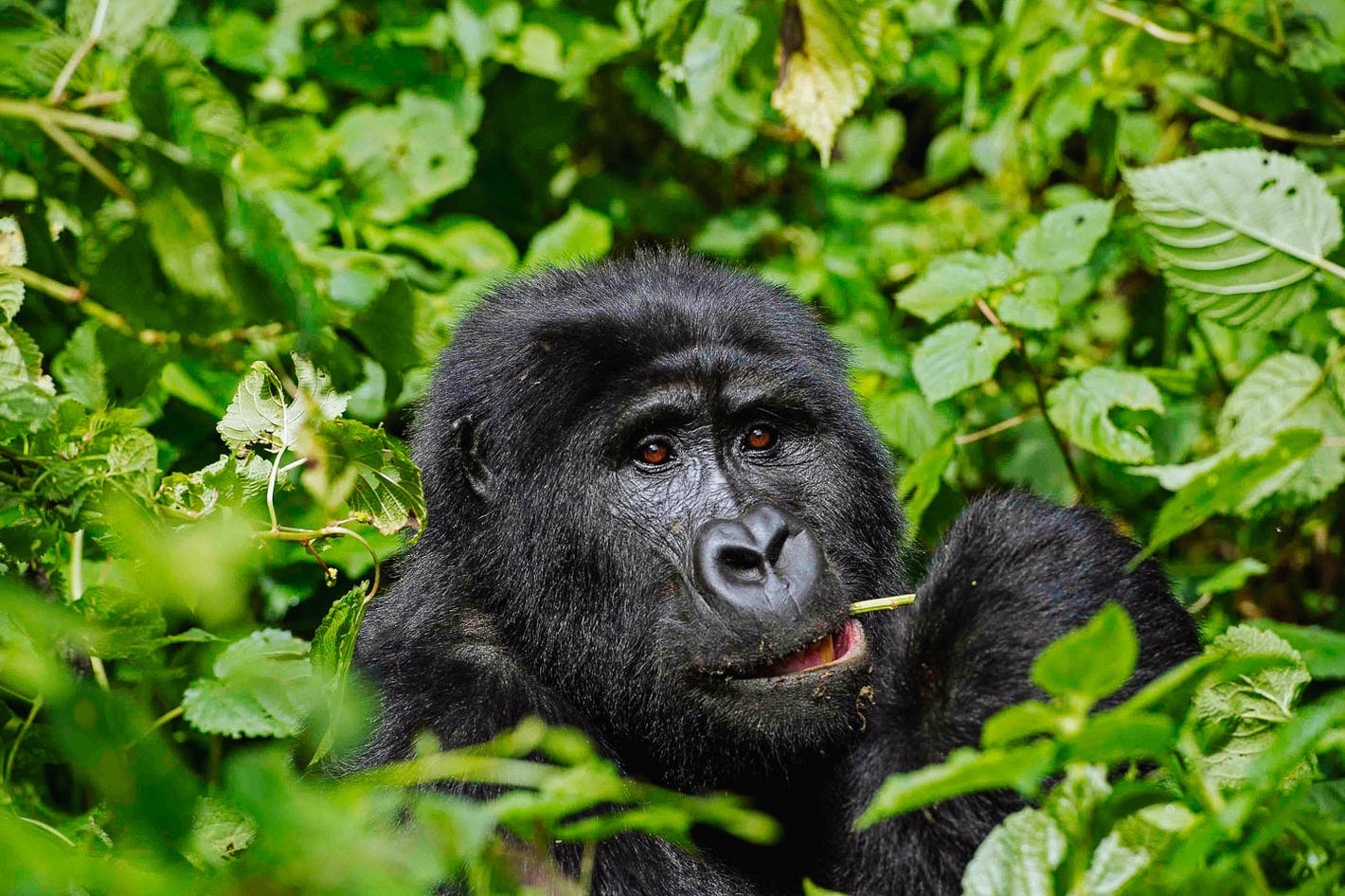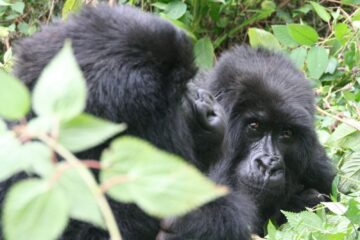Best destinations to go gorilla trekking in Africa
Mountain gorilla trekking have become very popular than the other subspecies of western lowland gorillas, eastern lowland gorillas and the cross river gorillas which all live in Central and East African rainforests. This is because, mountain gorilla population is less compared to that of the other subspecies of gorillas although both are categorized as critically endangered by the IUCN. There are 880 Mountain gorillas (World Wildlife Fund) living in Rwanda, Democratic Republic of Congo and Uganda. Uganda holds half of their total population; about 480 gorillas live in Bwindi impenetrable forest national park and few of them in Mgahinga gorilla national park. Primatologists such as George Schaller and Dian Fossey’s research for conservation of mountain gorillas did a lot to fetch support for saving these apes which were nearly getting extinct due to human poaching, habitat loss and civil wars.
DIAN FOSSEY GORILLA FUND IN RWANDA
Dian Fossey’s research became a foundation for the increasing massive gorilla conservation campaigns worldwide. During the 1970’s Mountain gorilla conservation project was initiated in Rwanda, Uganda and DR Congo undermining human encroachment and poaching. Gorilla national parks were established and their boundaries marked by creating buffer zones that would limit human-wildlife conflicts. In Uganda, Bwindi impenetrable forest national park and Mgahinga national park in southwestern Uganda were established as well as Volcanoes National park in Rwanda and Virunga National Park in DRC. Monitoring of gorillas also increased with establishment park rangers who provide security and gorilla doctors who monitor their health on a daily basis through the ranger based monitoring program. As a result of strong trans-boundary conservation between Uganda, Rwanda and DRC have seen mountain gorilla numbers increase from less than 500 individuals. The movie Virunga documented an increase in gorilla population in virunga national park despite decades of civil wars.
How to Conserve gorillas from human disturbance
To keep the gorillas from human disturbance, a set of gorilla tracking rules and regulations were set. In Rwanda and Uganda, only 8 tourists are permitted to see habituated gorilla families for one hour with the help of guides and park rangers while in DRC only six tourists can track the five habituated gorilla families in Virunga National Park.
Seeing gorillas in Rwanda, Uganda and DRC is guaranteed because gorillas are closely followed on a daily basis by a team of trackers. You just need to assess your fitness levels because tracking involves hiking through steep mountain slopes.
Tourists planning to take on a gorilla trekking safari in Uganda, Rwanda or DRC need to get in touch with a local tour operator and book your gorilla trekking permit earlier since there is high competition for gorilla trekking.
With gorilla tourism allowing few tourists to see gorillas at a cost, revenues from tourism have helped to fund local community development through diversification of tourism products beyond gorilla tourism. Projects such as cultural villages, sustainable agriculture, schools, heath care and livestock rearing generate income for local people who live around the gorilla national parks.
As a result, poaching and encroachment have significantly reduced. Most of the tourists who come for gorilla tracking also visit the local communities around the gorilla national parks mainly for culture and community tourism.
When choosing a destination for gorilla tracking, tourists tend to consider things such as additional tourist activities, accommodation, landscape sceneries, the cost of gorilla permit, distance between cities and gorilla national parks. Such differences determine why some of the gorilla destinations are popular than the others.
Rwanda, the Land of a Thousand Hills
Rwanda bordered by Uganda, Burundi and DRC is located in the Albertine rift valley south of the equator. The country has three high altitude volcanic mountains of Karisimbi, Muhabura and Bisoke which provide home to its endangered mountain gorillas and also form an integral part of the virunga massifs.
Gorilla tracking in Rwanda takes place in volcanoes national park located in the Musanze district Northern Province. Covering about 125 sq km, the park’s main tourist attractions are the mountain gorillas. It’s also a home to several mammals such as forest buffalos, elephants, warthogs, bush duiker, several species of birds and the rare Golden monkeys which also attract tourists.
Volcanoes National Park is a popular gorilla tracking destination because of its comparable advantages in relation to other gorilla national parks which include the following:-
Quick accessibility of Volcanoes National Park from Kigali International Airport, it takes 2 hours to drive by car from Kigali airport to the park on good tarmac roads hence most time bound travelers make it their number one choice for gorilla tracking. Therefore travelers who would want to track gorilla and make their return flight on the same day will opt for Rwanda. So the expensive Rwanda gorilla permit is counterbalanced by ground transport costs that one would incur in Uganda and DRC.
Secondary, the vegetation cover in Volcanoes National Park is dominated much by bamboo forests which are easier to traverse than the thick and impenetrable Bwindi National Park. This means that Rwanda offers the best scenario of unobstructed gorilla viewing and photographing. However foliage can be dense especially during the rainy season and clear views are not guaranteed since gorillas especially females and babies tend to climb high in the trees foraging or praying.
There are 10 habituated families of gorillas in Volcanoes National Park including some of the individual gorillas that were studied by the famous Dian Fossey. Primatologists and researchers in this case find it impressive to track some of those gorilla families to associate and pay tribute to legend Dian Fossey.
In terms of accommodations, Rwanda offers some of the best high end, midrange and budget lodges, hotels and camps which are not far away from kinigi the main gorilla tracking point. They include Five Volcanoes Boutique lodge (5 star), Virunga lodge, Sabinyo Silverback lodge, Gorilla nest lodge, le bamboo gorilla lodge, hotel Muhabura, gorilla Volcanoes hotel, Villa gorilla lodge among others.
All the above attributes combined make the cost of purchasing a gorilla permit in Rwanda not too expensive at $ 750 per person in comparison to Ugandan gorilla permit at $ 600per person. It means costs would be covered up in ground transportation from Entebbe airport to Bwindi impenetrable forest and Mgahinga national parks which takes 8-10 hour driving and 2 hours by charter flights.
Most tourists who come for gorilla tracking in Volcanoes National Park also go for different activities such as the hike to the Dian Fossey grave site, Golden Monkey tracking, Volcano Climbing, bird watching,culture and community walks.
Uganda, the Pearl of Africa
Bwindi Impenetrable Forest National is another popular gorilla tracking destination in southwestern Uganda. The 331 sq km park is holds 480 gorillas which make half of the world’s gorilla population. This implies that there are higher numbers of gorillas to see than in Rwanda and DRC. In addition to the higher number of gorillas, Bwindi impenetrable forest national park is biologically diverse with 120 species of mammals, 346 species including 27 Albertine rift endemics, over 200 species of butterflies, 27 frogs and over 1000 flowering plants.
Bwindi Impenetrable Forest is a UNESCO world heritage site where two great apes that is mountain gorillas and chimpanzee live in harmony with man. Therefore it’s a destination loved by nature lovers, primatologists, researchers and adventure travelers. There is a lot more of tourist activities to do than in Volcanoes Rwanda.
Although the distance from Kampala or Entebbe airport to the park is long covering about 512 sq km which can take 8-10 hours by car, there is a lot of amazing attractions along the way. One can stop at the equator line for experimentation and photographing or pass through Queen Elizabeth national park in Ishasha sector to spot tree climbing lions. Hence the long journey will end up becoming short due to amazing vistas including the lake Bunyonyi in Kabale and rolling terraced hills of Kisoro.
Gorilla tracking is well established in Bwindi Impenetrable Forest National Park, there are four gorilla tracking trail heads of Ruhija, Nkuringo, Rushaga and Buhoma the park headquarters. Each trailhead has got more than two habituated gorilla families which make it easier to for tourists to choose a section with a different tracking experience, professional guides and trackers.
There are also accommodations near those tracking points which are convenient for tourists to wake up early for gorilla briefing at 07:30am. Sometimes gorillas might feed on lower slopes or along the park boundaries like in Buhoma, if lucky; you might encounter them minus trekking for long hours.
Another advantage with tracking gorillas in Bwindi impenetrable forest national park is that trailheads are located in different part of the forest at different altitudes with unique gorilla families. For instance Buhoma is situated in the northern part at lower altitudes while Ruhija is the highest peak of the park at 2,350 meters above sea level. Tourists can choose a section to track gorillas from depending on their fitness levels which is not the case in Rwanda. There are 14 habituated gorilla families of which one lives in Mgahinga gorilla national park. Tourists can book for specific groups of gorillas which is not possible in Rwanda. A gorilla permit in Uganda costs $700 per person. Contact a local tour operator in Uganda to secure for you a gorilla permit.
Although Bwindi national park is dubbed impenetrable due to its thick vegetation, the habituated gorilla families are well known to be very sociable hence good for viewing and quite fair for photographing. Being an impenetrable forest with thick vegetation, it’s a good place to have an adventure experience in the jungle. The forest is believed to have survived the ice age about 25,000 years ago. In the heart of the forest you will find sparkling water falls, fast flowing rivers, old mahogany trees, orchids and tree ferns. The forest is also a home to wild chimpanzees along with other 10 species of primates such as red tailed monkey, L’hoest monkey, blue monkey, black and white Colobus monkey, bush babies and several others.
Democratic Republic of Congo
Gorilla tracking tours in the DR Congo take place in the Virunga National park which is located in the eastern side of the country. Virunga National park is the oldest national park in Africa gazzetted in 1925 to protect the endangered mountain gorillas and other critically endangered wildlife such as okapi and two species of chimpanzees including the Bonobo.
This UNESCO world heritage site has unmatched biological diversity that comprise of tropical forests, flood plains, active volcanoes, savannahs, swamps and snow capped Mt. Rwenzori (mountains of the moon). Tourists who come to this park for gorilla tracking will also explore one of the untamed rainforests offering an authentic wilderness experience.
DRC has got both mountain gorillas and the other subspecies of the eastern lowland gorillas in Kahuzi-Biega National Park. Eastern lowland gorillas have short fur on the body but more similar to mountain gorillas hence tourists can track both subspecies of gorillas once in DRC, an experience that you won’t get in Uganda or Rwanda.
A couple of decades ago, DRC used to be feared by most tourists due to civil wars that destabilized tourism. Fortunately, wars have faded away due to increased security by Virunga National Park rangers and the UN peacekeeping forces. Gorilla safaris now days take tourists into the DRC without any security threat.
Once you book a gorilla tour with a tour operator, you are guaranteed to encounter gorillas in their natural habitat. The Congolese institute for conservation of wildlife and nature together with Virunga National Park Authorities habituated 5 gorilla families which are open for tourists.
Tourists have an advantage of cheap gorilla permits in DRC at $400 per person which is issued by Virunga National Park Authorities. Gorilla watching in comparison with Uganda and Rwanda is quite good due to fewer tourists who visit virunga national park. In addition to being less visited, only 6 people are allowed to see gorillas contrary to 8 people in Rwanda and Uganda hence you are likely to track minus crowds. Tourists wear surgical masks not to transmit respiratory infectious diseases like colds to gorillas.
Accessibility of Virunga National Park is another factor why most tourists opt for gorilla tracking in Uganda and Rwanda. Most tourists access DRC either from Rwanda via the Gisenyi/Goma border or through southwestern Uganda via the Bunagana border which is not convenient for most travelers. In addition, roads leading to Virunga National Park are not tarmac and you must use a 4 wheel vehicle.
To conclude about the highlights of the best gorilla tracking destination, Rwanda’s volcanoes national park tops due to ease accessibility, bamboo terrain which makes watching gorillas easier. Bwindi impenetrable forest national park in Uganda comes second because of its high number of gorillas; in addition there are a lot of adventure tourist activities to do such as birding, nature walks, wildlife viewing whereas DRC has two subspecies of gorillas that is the mountain gorillas and the eastern lowland gorillas.
Note, however, tourists planning for a gorilla safari in either of the gorilla national park, need to arrange their safaris in advance of 3-4 months. The climatic conditions are pleasantly tropical with warm and wet weather conditions.
Gorilla tracking is done all year round but the best time would be during the dry season between December to February and June to September while the wet season is usually between October to November and March to May.
Rainfall amounts are very high even during the dry seasons. You need to pack hiking gears such as hiking boots, a pair of warm clothing, long pants, gaiters, long sleeved shirts, gloves, hut, sunscreen, insect repellant and camera equipments.
Being tropical areas, there is a risk of malaria and yellow fever. You need to secure a world health organization yellow fever vaccination card and malaria treatment. Mountain climbers should also know the risk of acute mountain sickness at higher altitudes hence must have medical prescription for it.





Tour Reviews
There are no reviews yet.
Leave a Review